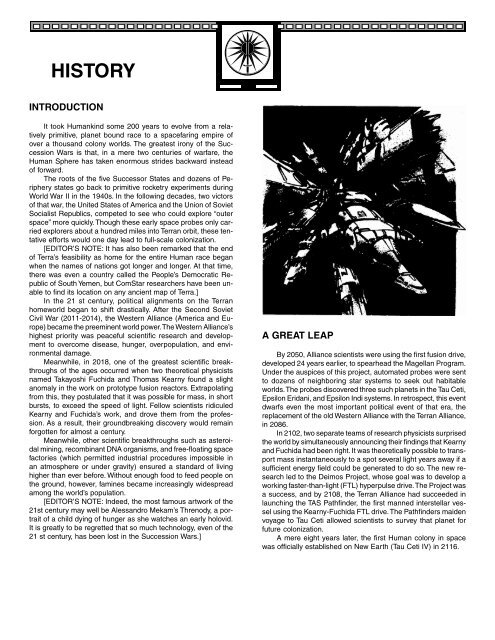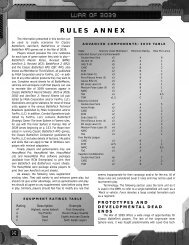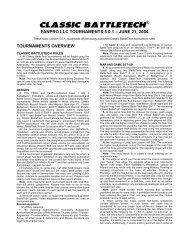You also want an ePaper? Increase the reach of your titles
YUMPU automatically turns print PDFs into web optimized ePapers that Google loves.
HISTORY<br />
INTRODUCTION<br />
It took Humankind some 200 years to evolve from a relatively<br />
primitive, planet bound race to a spacefaring empire of<br />
over a thousand colony worlds. The greatest irony of the Succession<br />
Wars is that, in a mere two centuries of warfare, the<br />
Human Sphere has taken enormous strides backward instead<br />
of forward.<br />
The roots of the five Successor States and dozens of Periphery<br />
states go back to primitive rocketry experiments during<br />
World War II in the 1940s. In the following decades, two victors<br />
of that war, the United States of America and the Union of Soviet<br />
Socialist Republics, competed to see who could explore “outer<br />
space” more quickly. Though these early space probes only carried<br />
explorers about a hundred miles into Terran orbit, these tentative<br />
efforts would one day lead to full-scale colonization.<br />
[EDITOR’S NOTE: It has also been remarked that the end<br />
of Terra’s feasibility as home for the entire Human race began<br />
when the names of nations got longer and longer. At that time,<br />
there was even a country called the People’s Democratic Republic<br />
of South Yemen, but ComStar researchers have been unable<br />
to find its location on any ancient map of Terra.]<br />
In the 21 st century, political alignments on the Terran<br />
homeworld began to shift drastically. After the Second Soviet<br />
Civil War (2011-2014), the Western Alliance (America and Europe)<br />
became the preeminent world power. The Western Alliance’s<br />
highest priority was peaceful scientific research and development<br />
to overcome disease, hunger, overpopulation, and environmental<br />
damage.<br />
Meanwhile, in 2018, one of the greatest scientific breakthroughs<br />
of the ages occurred when two theoretical physicists<br />
named Takayoshi Fuchida and Thomas Kearny found a slight<br />
anomaly in the work on prototype fusion reactors. Extrapolating<br />
from this, they postulated that it was possible for mass, in short<br />
bursts, to exceed the speed of light. Fellow scientists ridiculed<br />
Kearny and Fuchida’s work, and drove them from the profession.<br />
As a result, their groundbreaking discovery would remain<br />
forgotten for almost a century.<br />
Meanwhile, other scientific breakthroughs such as asteroidal<br />
mining, recombinant DNA organisms, and free-floating space<br />
factories (which permitted industrial procedures impossible in<br />
an atmosphere or under gravity) ensured a standard of living<br />
higher than ever before. Without enough food to feed people on<br />
the ground, however, famines became increasingly widespread<br />
among the world’s population.<br />
[EDITOR’S NOTE: Indeed, the most famous artwork of the<br />
21st century may well be Alessandro Mekam’s Threnody, a portrait<br />
of a child dying of hunger as she watches an early holovid.<br />
It is greatly to be regretted that so much technology, even of the<br />
21 st century, has been lost in the Succession Wars.]<br />
A GREAT LEAP<br />
By 2050, Alliance scientists were using the first fusion drive,<br />
developed 24 years earlier, to spearhead the Magellan Program.<br />
Under the auspices of this project, automated probes were sent<br />
to dozens of neighboring star systems to seek out habitable<br />
worlds. The probes discovered three such planets in the Tau Ceti,<br />
Epsilon Eridani, and Epsilon Indi systems. In retrospect, this event<br />
dwarfs even the most important political event of that era, the<br />
replacement of the old Western Alliance with the Terran Alliance,<br />
in 2086.<br />
In 2102, two separate teams of research physicists surprised<br />
the world by simultaneously announcing their findings that Kearny<br />
and Fuchida had been right. It was theoretically possible to transport<br />
mass instantaneously to a spot several light years away if a<br />
sufficient energy field could be generated to do so. The new research<br />
led to the Deimos Project, whose goal was to develop a<br />
working faster-than-light (FTL) hyperpulse drive. The Project was<br />
a success, and by 2108, the Terran Alliance had succeeded in<br />
launching the TAS Pathfinder, the first manned interstellar vessel<br />
using the Kearny-Fuchida FTL drive. The Pathfinders maiden<br />
voyage to Tau Ceti allowed scientists to survey that planet for<br />
future colonization.<br />
A mere eight years later, the first Human colony in space<br />
was officially established on New Earth (Tau Ceti IV) in 2116.




